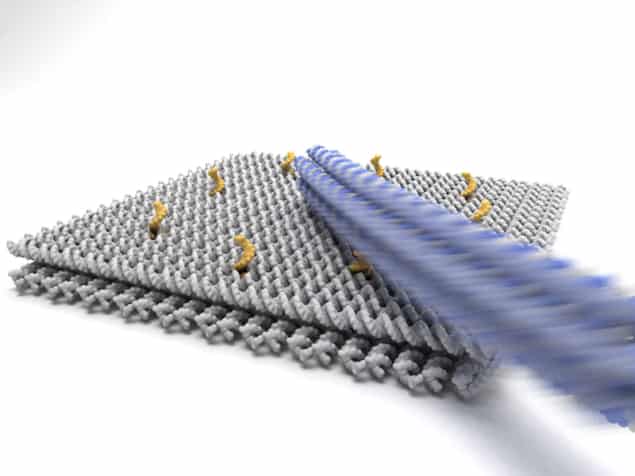
A new “robot arm” consisting of a square base and a protruding “gear stick”, all made of DNA double helices, that can be driven by electrical fields alone, can move 100,000 times faster in solution than other machines based on DNA molecules. The nanorobot, which is made using the “DNA origami” technique, could find use in robotics applications, such as cargo transfer, in biosensing, digital memory and even to make nanoassembly systems.
DNA origami has proved itself to be a powerful way to build sophisticated nanostructures for use in a wide range of devices – from computing components to drug carriers. This technique was first developed more than 10 years ago by Paul Rothemund at The California Institute of Technology, and involves forcing a large viral genome to bend by adding small, synthetic DNA sequences to it in solution. The shorter segments attach to the main genome and act as “staples” that hold the DNA in a range of shapes such as squares, triangles and stars measuring just 100–150 nm across.
Researchers have successfully used DNA origami to make devices such as nanoscale robotic walkers, assembly lines and molecular arms that can move. However, because these systems are driven by phenomena such as DNA hybridization reactions, by the addition of chemical fuel or light-switchable molecules, or changes in buffer composition, they unfortunately move quite slowly. They are unable to exert sufficiently high forces against external loads either, so cannot be used for cargo transfer, for example.
A team led by Friedrich Simmel at the Technical University Munich and the Nanosystems Initiative Munich in Germany have now taken a different approach to move DNA nanomachines – by using electric fields. Thanks to this technique, their DNA robotic system, which consists of a square base and a protruding arm, all made of rigid DNA double helices, can point and rotate in different directions much faster than devices that rely on DNA molecular forces alone.
3D DNA platform attached to a flexible rod
The nanorobot is made of a 3D DNA platform attached to a flexible rod on a glass slide with flexible single-stranded DNA pieces, or “latches”. The rod looks and behaves rather like a gear lever that sticks out of the square platform, with the DNA strands grabbing and locking the arm into predefined positions. The arm can then only move into a new position when a high enough electric field is applied to it.
“Applying an electric field to the arm allows us to switch its position within just milliseconds, which is at least five orders of magnitude faster than that possible using previously employed approaches,” explains Simmel. “We can also computer-control the motion and thus produce complicated movement patterns, such as rotations with various frequencies or motion between dedicated docking sites on the platform. We can move nanoparticles and molecules with the arm too and exert molecular forces (of piconewtons) with it.”
The researchers made their devices using DNA self-assembly with the origami technique and created a platform measuring 55 nm x 55 nm with the integrated molecular arm (length: 25 nm) that can rotate around a hinge at the centre of the platform and be extended to more than 400 nm. “We produced a dedicated sample chamber in which we immobilized millions of these robot arm structures and controlled their rotational motion with several electrodes contacting the chamber. We can easily manipulate DNA with electrical fields because it is highly charged. Indeed, biologists working in gel electrophoresis labs do such experiments every day.”
Biosensing, synthesis and nanoassembly applications
Our work on electrical manipulations points to a new future for such devices in robotic systems that may be useful for biosensing or synthesis applications, he tells nanotechweb.org. One other area is to make nanoassembly lines in which multiple arms cooperate to construct complex nanostructures.
“In a sense, our system is also the first example of a nanoelectromechanical (NEM) device in which a biomolecular nanostructure is manipulated in buffer.”
The researchers, reporting on their work in Science DOI: 10.1126/science.aao4284, say that they will now be extending their system so that it can reliably pick up and release particles or molecules in a controlled way and thus move objects from one area to another. “We will also be trying to use the arm to control chemical processes through mechanical co-localization of either reactants or of enzymes and cofactors/substrates,” says Simmel. “The simplest chemistry for us in this context would be to control DNA or RNA polymerization or ligation.”
The basis for new types of digital memory and 3D printing
“Since the movement of the arm is influenced by chemical binding processes on the platform, we will also be working on using it as a single-molecular biosensor with which we can probe and characterize molecular interactions between biomolecules such as antigens and antibodies, or DNA-protein binding. And, in contrast to other techniques, ours could be comparatively cheap.”
The new nanorobot may serve as the basis for new types of digital memory and also 3D printing, comments Björn Högberg of the Karolinska Institute, Sweden, in a related Perspective article.
“Remote-controlled picking up and placing of molecular components could potentially be accomplished if this concept was combined with cargo-transfer techniques,” he writes. “If this became possible, one could imagine a future where molecules could be put together following orders from an outside operator. DNA origami is effectively already a 3D-printer system for the nanoscale but with some of these extensions, [the new] technique could enable true 3D printing of molecules.”



